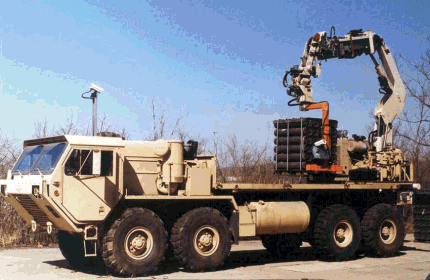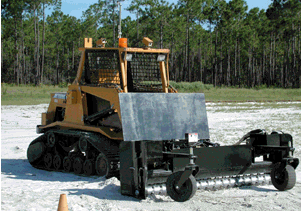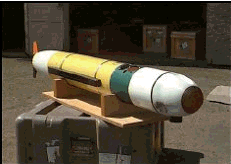|
|
Robots in the Military
|
 |
Pretty much by definition, the
military is a dangerous place for humans. This makes it
a logical application for robotics, but I definitely
have mixed feelings about that. I can live with robots
assisting soldiers, but automated killing is taking it
too far. At left we see the Smart Crane Ammunition
Transfer System being developed by the Robotics
Research Corporation. The goal is for one soldier to be
able to unload the entire truck without ever leaving the
cab. The system includes cameras, video screens, force
sensors and special grippers. |
|
|
|
The photo at right shows a robotic
mine-sweeper. It is basically a tractor with a bunch of
swinging chains mounted on the front. These chains pound
the ground with significant forces to explode any buried
mines. Using GPS and relatively simple control
algorithms, robots such as these can be programmed to
methodically cover large areas of ground in a perfect
grid. Vehicles like this can also be equipped with water cutting tools
to cut into and through explosive ordnance, water cannons
to disperse unruly mobs and charge setters to explode
suspicious packages. For these operations the unmanned
vehicle would be teleoperated. |
|

|
|
|
 |
The Predator shown at left has
probably become our military's most famous unmanned
vehicle. It is essentially a super high-tech r/c plane
though it does have some autonomous flying capabilities.
Originally designed for reconnaissance, it now can be
outfitted with a variety of different weaponry, most
recently the laser-guided AGM-114 Hellfire anti-armor missiles.
It is roughly 29 feet long with a 49 foot wingspan.
Since 1995, the Predator has seen action over Iraq,
Bosnia, Kosovo and Afghanistan. |
|
|
|
The photo at right shows an unmanned underwater vehicle that
was developed by Woods Hole Oceanographic Institution (WHOI) under ONR support.
It performs reconnaissance (hydrographic and side-scan sonar surveys) in littoral waters, from the seaward edge of the surf zone into waters as deep as 100 meters. The vehicle is small, capable of deployment by two
people, and can be launched and recovered from a small vessel without a crane or other special handling equipment. It can operate over 20 hours on battery power before recharging and is capable of speeds over 2.5 meters per second.
It operates completely autonomously. |

|
|
|
|